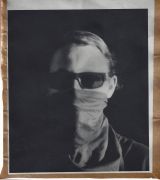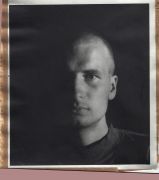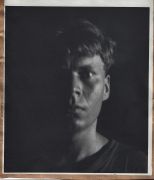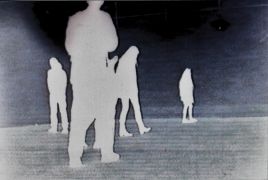Inside of an empty Baroque chapel, the movement of people resulted in resonating sounds which resounded in different quantities and intensities, depending on the number of visitors and their movements. The variable sound structure created varied in range, from the threshold of hearing to the threshold of pain.
Along the chapel walls, eight IR sensors were installed, by means of which a computer registered and evaluated the movement of people. Based on the data acquired, it picked up resonance sounds from a memory database of sample sounds, and transmitted them to speakers, which were placed in such a manner that a listener could not specify the source of a specific sound. The resonance sounds were created from the recorded tones of the churchbells of Prague, and they were arranged into a structure based on the pentatonic scale. The sound equipment was adjusted specially for the acoustic qualities of the Bernard chapel and positioned in such a way that sounds were reflected, broken and amplified by the space.
Amnesty is a sound installation that strongly impacts the visitors' senses by means of carefully processed and very dynamic sounds. By connecting a sacred Christian space and an Oriental musical scale, cosmic sounds and artificial intelligence, it gives evidence of the relationship between the past, present and future in the contemporary world.
Hardware (installation): Emax II, 8MB RAM
PC XT/AT, 1MB RAM, custom MIDI card
IR sensors AEI PIR-9038L
4 amplifiers 2 x 50-100 W
guitar combo 200 W
8 speakers 50 - 100 W.
Software (installation): MS DOS, custom software
Petr Svárovský (born 1962 in Mladá Boleslav, Czechoslovakia) is a new media artist and designer who lives and works in Oslo, Norway. He is interested in the interrelation between art, technology and cognitive studies (consciousness). Svarovsky participated in Plasy on three symposia (works: Cradle 95, Sirens, Platforms - 1998). Svárovský started his artistic career in the mid 90’s when he co-founded Silver, a collaborative platform for new media art production (with a.o. Milan Guštar and Pavel Rejholec). Since then, he has worked within the field of interactive sound installations, advanced virtual reality, investigated the possibilities of Internet as an art medium and how to utilize mobile phones for art. In 2012, he founded the company Carrot Pop, legendary mostly for controversial apps, in Oslo, his place of residence since 2003 . He stopped to call his production 'art' and developed a number of apps, driving their users into an unusual physical experience. Petr Svárovský uses mobile and social media to create public interventions, events and challenges as a new context of artistic expression. Nowadays, he is also experimenting with biotechnologies.
Petr Svárovský exhibited his work internationally at institutions including Laboral (Gijon, Spain), the Netherlands Media Arts Institute (Amsterdam, The Netherlands), the Hennie Onstad Kultursenter (Oslo, Norway) and the Ars Electronica Center (Linz, Austria), at independent venues and galleries including UKS (Oslo, Norway), Backspace (London, United Kingdom), STATIC (Liverpool, United Kingdom) and Aktions Galerie (Berlin, Germany), and at festivals including the FILE Festival (Sao Paolo, Brazil), Ars Electronica (Linz) and the Venice Biennale (Venice, Italy). He has given presentations and lectures at different events, including the ISEA 2010 (Duisburg, Germany), Arts and Business in Digital Times (BI, Oslo, Norway) and Fine Art Training and the European Higher Education Area (Univesitat Politecnica de Valencia, Valencia, Spain).
Milan Guštar (born 1963 in Kolín, Czechoslovakia) is an organologist, composer, computer programmer, and designer of electronic, electroacoustic, multimedia, and interactive systems. Since the 1980s, Guštar’s name has been appearing repeatedly within the context of independent film, theatre, the alternative music scene and later also the audio-visual art scene. His work on the one hand contains elements of strict logical thinking and a certain trace of mathematical dryness, but on the other hand it reveals a preoccupation with the world of the sensual, magical and the eccentric.
He studied computing at Czech Technical University in Prague (1981–86). After completing his studies, he stayed on as a lecturer (1986–92). During the 1990s, he spent several working exchanges at San Jose State University in the United States. Later, he studied information science and applied mathematics at the Technical University of Ostrava (1999–2003), where he received a Ph.D. From 2002 to 2008, he was a research employee at the Czech Academy of Sciences in the field of mathematic modeling and systems simulations. Although Guštar has been actively involved in music since childhood, his original interest was more theoretical. His current relationship to music is based on a Pythagorean understanding of the world as a manifestation of numeric principles. Guštar is an expert in practically the entire field of low-current electrical equipment and electronics, and has managed to apply his theoretical knowledge in practice by collaborating on the design of audio, video, and audiovisual objects. Since the late 1970s, his work has focused on the design, development, and manufacture of custom-made electronic and electroacoustic equipment and musical instruments, multimedia and interactive systems, software design, audio recording and editing, and consultation services. Since 1993, he has been engaged in these activities under the company name ARTech. He specializes in working with visual and other artists in the creation of multimedia, interactive, and kinetic works (artists with whom he has collaborated include David Černý, Krištof Kintera, Veronika Bromová, Radim Labuda, Kurt Gebauer, Miloš Vojtěchovský, Floex, Michael Bielicky, Jan Mucska, Federico Diaz, Lukáš Rittstein, Petr Svárovský, Petra Vargová, and Gabriela Jurkovičová). In the area of theory, Guštar is focused on interdisciplinary research in electronics, information science and applied mathematics, modeling and simulations, mathematical principles in music and art, the theory of tone systems, algorithmic compositions, and sonification. Mathematical principles also appear in his compositions and audio and multimedia installations, for which Guštar often utilizes his theoretical and practical experience of electronics and electroacoustics. He occasionally lectures at Prague’s Academy of Fine Arts, Film and Television School (FAMU), Music and Dance Faculty of the Academy of Performing Arts (HAMU), and Charles University’s Faculty of Arts, among others. His knowledge of the intentional creation and modification of source sounds using electronics is summarized in the two-volume Electrophonics, in which he looks at the prehistory, history, and current state of this field from the viewpoint of organology and electrotechnics. He is also capable of manufacturing the electronic and electromechanical musical instruments and equipment whose construction and functioning are described in his writings. Among others, Guštar has created electronic organs (6 octaves, 5 stops), monophonic synthesizers, programmable electronic drums, MIDI keyboards, a MIDI Timecode Display and a theremin. Guštar’s books and audio CDs have been released by his own publishing house, Uvnitř.
Pavel Rejholec is a sound designer, re-recording mixer, managing director of Soundsquare and, above all, a golfer. He is the head of the Sound department at the Film and Television Faculty of AMU in Prague.






